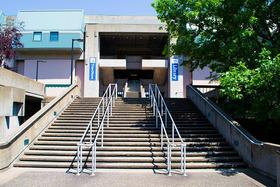- Bryan University is a private for-profit university based in Tempe, Arizona. It has additional campuses in Toronto and Portland, Oregon.
School Highlights
Bryan University serves 3,303 students (100% of students are full-time).
The college's student-teacher ratio of 27:1 is higher than the state community college average of 22:1.
Minority enrollment is 60% of the student body (majority Black), which is less than the state average of 61%.
Quick Facts (2025-26)
- Enrollment: 3,303 students
- In-state tuition: $11,850
- Out-state tuition: $11,850
- Acceptance Rate: 100%
- Student-teacher ratio: 27:1
- Minority enrollment: 60%
- Source: Integrated Postsecondary Education Data System (IPEDS)
Top Rankings
Bryan University ranks among the top 20% of public schools in Arizona for:
Category
Attribute
Diversity
School Overview
The teacher population of 123 teachers has stayed relatively flat over five years.
Bryan University
(AZ) Community College Avg.
Carnegie Classification
Baccalaureate/Associate's Colleges: Mixed Baccalaureate/Associate's
Baccalaureate/Associate's Colleges: Mixed Baccalaureate/Associate's
Institution Level
Less than 2 yrs
At least 2 but less than 4 years
Institution Control
Public
Public
Year Founded
1940
Total Faculty
123 staff
202 staff
School Calendar
Student Body
The student population of Bryan University has grown by 196% over five years.
The student-teacher ratio of 27:1 has increased from 11:1 over five years.
The Bryan University diversity score of 0.73 is more than the state average of 0.71. The school's diversity has stayed relatively flat over five years.
Total Enrollment
3,303 students
5,392 students
Student-Teacher Ratio
27:1
22:1
# Full-Time Students
3,303 students
1,208 students
# Part-Time Students
n/a
4,184 students
# Enrollment Undergraduate
329 students
339 students
# Full-Time Undergraduate Students
3,290 students
1,238 students
# Full-Time Graduate Students
13 students
66 students
# Part-Time Undergraduate Students
n/a
5,400 students
# Part-Time Graduate Students
n/a
11 students
Total Dormitory Capacity
n/a
250 students
% American Indian/Alaskan
1%
3%
% Asian
1%
4%
% Hispanic
9%
36%
% Black
24%
7%
% White
40%
39%
% Hawaiian
1%
2%
% Two or more races
8%
4%
% Non Resident races
n/a
1%
% Unknown races
16%
4%
Diversity Score
0.73
0.71
College Completion Rate (Students who graduate in less than 4 years)
10%
20%
College Completion Rate (Students who graduate in 4 years or more than 4 years)
32%
60%
Average Graduate Earnings (10 Years)
$43,500
$32,900
Tuition and Acceptance Rate
The public in-state tuition of $11,850 is more than the state average of $3,445. The in-state tuition has stayed relatively flat over four years.
The public out-state tuition of $11,850 is more than the state average of $8,201. The out-state tuition has stayed relatively flat over four years.
In-State Tuition Fees
$11,850
$3,445
Out-State Tuition Fees
$11,850
$8,201
% Students Receiving Some Financial Aid
88%
82%
Median Debt for Graduates
$19,723
$9,500
Median Debt for Dropouts
$7,301
$4,750
Acceptance Rate
100%
71%
Source: 2024 (or latest year available) Integrated Postsecondary Education Data System (IPEDS) , School Administrators
Frequently Asked Questions
How much does Bryan University cost?
Bryan University's tuition is approximately $11,850 for In-State students and $11,850 for Out-State students.
What is the acceptance rate of Bryan University?
The acceptance rate of Bryan University is 100%, which is higher than the state average of 71%.
What is Bryan University's ranking?
Bryan University ranks among the top 20% of community college in Arizona for: Diversity in US community colleges.
Recent Articles

How to Transfer from Community College to a Four-Year University in 2025
A step-by-step guide for community college students transferring to a four-year university in 2025 — updated strategies, data and expert insights.

Scholarships for Community College Students 2025
Explore updated scholarship programs, tuition data, and expert strategies for community college students in 2025.

The Rise of Technical and Vocational Training in 2025
Explore the 2025 surge in technical and vocational training—enrollment, policy, costs, and why this path is gaining ground for students and parents.





